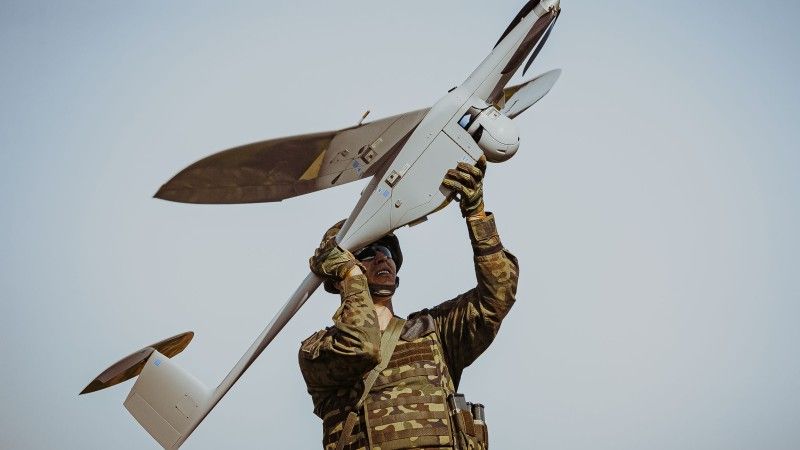Land Forces
Poland Procures FlyEye UAVs for Artillery Units and Major Quantity of Loitering Munitions

Photo. Territorial Defence Forces
Head of the Polish Ministry of Defence, Mariusz Błaszczak, announced that the MoD would restart procurement of the FlyEye UAVs next year, to commission them in the Artillery/Rocket Artillery units. Błaszczak also noted that the Armament Agency would also deal with the acquisition of loitering munitions
Mariusz Błaszczak approved a contract yesterday, concerning the Wizjer programme UAVs. The procured platform has been designed by the Air Force Institute of Technology [ITWL], while manufacturing would be handled jointly by a consortium, led by the PGZ Group, and involving WZL No. 1, and WZL no. 2 facilities. Deliveries of 25 packages and 100 UAVs would be taking place between 2024 and 2027. The above refers to mini-UAVs for battalion level applications in the Land Forces, and the SOF component. The agreement value is defined as PLN 174 million.
Signing the agreement, Błaszczak also announced a plan to procure other UAVs. The fact that drones are necessary, important on the modern battlefield, is undisputed, said Błaszczak, not only referring to recent conflicts but also to the tensions on the Polish-Belorussian border, where reconnaissance UAV systems are used on both sides. The Belorussians use them as reconnaissance assets to identify the gaps in border protection. The Polish side also uses UAVs - this refers to the FlyEye systems operated by the Territorial Defence component, or Orbiter systems hailing from the 12th Airbase in Mirosławiec.
The head of the Polish MoD said that the Ministry is willing to “acquire drones for the Polish Military using several different sources", not to become dependent on a single supplier.
-- During a meeting of the Technical Modernization Council, a decision was made to restart FlyEye deliveries, said Błaszczak. He added that the drones that are going to be procured would be received primarily by the artillery units. He also recalled the fact that the 21st Highland Brigade has recently received a Krab sph battery. These guns manufactured by HSW S.A. utilize the ZZKO Topaz FCS by the WB Group - it may work directly with the FlyEye UAV in target designation and adjustment of firing solutions.
Up until now, the artillery units have had only a minor quantity of those UAVs at their disposal. Nonetheless, the joint use of artillery assets and UAVs is a well-proven operational scheme - during the Afghan deployment, these tactics were employed with the Dana wheeled howitzers. The procurement of the UAVs listed above may be viewed as a major reinforcement of the Polish artillery. A single set - control station plus 4 UAVs - costs around PLN 4 million, if previous procurements are taken into the account. A relevant procedural framework has already been put in place, for employing the FlyEye systems in the artillery. The said scheme is quite proven.
The head of the Polish Ministry of Defence also announced a plan to procure loitering munitions, to gradually increase the saturation of the battlefield involving these assets. The above would be one of the first tasks for the newly-established Armament Agency. Currently, the Polish Armed Forces have only a minor quantity of light Warmate loitering munitions at their disposal - in the inventory of the Territorial Defence component.
Talking to us, Krzysztof Płatek, spokesman for the Armament Inspectorate, told us that soon, a procurement procedure concerning a loitering munitions system would begin, under the name GLADIUS. The programme in question is relatively obscure. The only publicly available information can be found in response to a parliamentary question asked by MP Stanisław Tyszka, issued by the Deputy Minister of Defence Wojciech Skurkiewicz, in May 2020: _"To increase the reconnaissance and long-distance strike capabilities the Polish Armed Forces have, beyond the range of the FlyEye short-range UAV, it is planned that unmanned search and strike systems would be procured for the artillery elements of the Army, named GLADIUS".
One may conclude then, that a procurement procedure would be launched, concerning a strike system of relatively long-range, carrying payload heavier than Warmate or DragonFly. Notably, FlyEye may attain a range of up to 50 km (the latest, 3.0 variant, 30 kilometres for the legacy systems).
Apart from the Gladius programme, the Armament Inspectorate has also been engaged in an analytical effort aimed at procurement of a lighter loitering munitions system, dubbed Sparrow. The technical dialogue involved 7 entities, listed below:
- Israeli Aerospace Industries Ltd.
- WB Electronics S.A.
- MetalExport-S Sp. z o.o.
- Optimum Sp.j.
- PGZ S.A.
- Works-11 Sp. z o.o.
- Poland-U.S. Operations Sp. z o.o.
If the declarations made by the Polish Ministry of Defence are implemented, this would translate into a major reinforcement of the potential the Polish land forces would have at their disposal, when it comes to unmanned platforms. This is quite relevant, as equipment as such has not been delivered during the recent years - the last of the FlyEye procurements was made with the Territorial Defence Forces in mind, while the Wizjer programme was suffering from serious, numerous delays. The use of strike and reconnaissance UAVs, especially ones embedded within an existing C2 system such as ZZKO Topaz, may, at a relatively low price-point, significantly enhance the available combat potential.